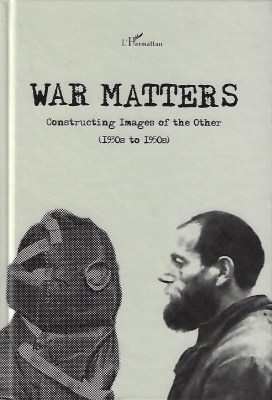
War Matters
Tytuł: War Matters. Constructing images of the other (1930s to 1950s) Redaktorzy: Dagnosław Demski, Liisi Laineste, Kamila Baraniecka-Olszewska Miejsce: Budapest Rok wydania: 2015 This volume addresses questions concerning rhe interrelations of three important variables: war, images and the Other. The explicit stereotypes and contrasts but also the implicit message in wartime images informs the attentive observer about the aims, motives and ideas of the author of the image. Focusing on caricatures and photographs, the volume brings together various accounts of wartirne imagery from mainly Eastern and Central Europe. The photograph is commonly perceived as a faithful record of reality. It is treated as an objective expression of a visual convention, exemplifying the way things are depicted at a given time. Deeper reflection, however, reveals how photography is at aIl times constructed and contextualised. This shows chat we cannot simply take what we are seeing or what we believe is being represented for granted. Photography may also convey information of the gro up identity of its aurhor, because through its atłinity to a particular way of thinking it often refers to a certain culture, typical to the In contrast, caricature sets off from different premises. The implicit aim of caricature is to sketch and exaggerate, not depict 'neutrally', The power of caricature is vested in the recognisable, although grossly and blatantly exaggerated, image of the Orher. Through analysing representations of war, the present volume presents, analyses and discusses these experiences in order to reach a comparative conclusion on how war matters in relation to images-i.e. how it affects the construction of the Other in a visual format. Acknowledgements Dagnosław Demski, Liisi Laineste, Kamila Baraniecka-Olszewska Represerrtations of the Other in rhe Time ofWar: Does War Matter? 1. Wartime Images: Marking out the Battlefield Christie Davies Constructing Images of the Other in Peace and War: Anglo-Saxon Perceptions and Their Relevance to Eastern and Central Europe Dagnosław Demski Living Images and Gestures in Wartime: The Other as an Iconoclastic Figure Alexander Kozintsev War Propaganda and Humour: World War II German, British, and Soviet Cartoon 2. Ideology and the Other: The Making of the Enemy Agnes Tamśs The Faces of the Enemy in the T wo W orld Wars: A Comparative Analysis of German and Hungarian Caricatures Anna M. Rosner German Jewish Migrations to Great Britain 1933-1939: Remarks on Culrural Otherness Anssi Halmesvirta The Old Foe Again: The Picrorial Image of the Ruskie (ryssa) in the Finnish Sports [ournal during the Winter War (1939–1940) Olli Kleemola Soviet Prisoners of War in F innish and German Propaganda Photography 1941–1944 Ilze Boldane-Zelenkova The Others in the Perception ofLatvians during World War II Magdalena Żakowska Male War, Female War: The Image of Russians and the Soviet Union in Nazi Propaganda from 1941 to 1945 Liisi Laineste, Margus Laane Images of the Enemy from Both Sides of the Front: The Case of Estonia (1942–1944) Zuzana Panczova Images of the Traitor and Enemy in Humour and Political Cartoons in Wartime Slovakia: Analysis of the Magazine Kocur Kamila Baraniecka-Olszewska Performing the New Enemy: Images from the Cold War in the Communist Polish Newspaper Trybuna Robotnicza Oleg Riabov American Femininity in Soviet Films during the Early Cold War (1946–1955) 3. Old Enemies, New Faces Tomasz Kalniuk Symbolic Migration to the Super-West in the Polish Pomeranian Press of the 1930s Ewa Manikowska Competing Visions ofLandscapes, Cultures and Peoples. Survey Photography in the Western Borderlands of the Russian Empire during World War I Eda Kalmre The Meaning of Photos in the Context of Memory and Remembering Dominika Czarnecka The Familiar Converted into the Other: Constructing Otherness Through the Monumental Representarions of the Red Army in Poland (1940s–1950s) Magdalena Sztandara 'A Woman from a Newspaper': A New Face for Ideology and Old Habits Ewa Baniowska-Kopacz Silesia-Stranger/Not Stranger. Creating Regional Identity in the Magazine Śląsk. Miesięcznik Ilustrowany Liudmila Limanskaya The Psychoanalytical Aspects of the Oeconstruction of Images of Socialist IdeaIs of the 1930s–1950s in Russian Sots Art of the 1990s–2000s List of Illustrations Contributors Informacje bibliograficzne
Wydawca: Estonian Literary Museum, Institute of Archaeology and Ethnology Polish Academy of Science
Język: angielski
Liczba stron: 463
Format: B5
Okładka: twarda
ISBN: 978-23-4307-233-3Opis
group of people to which che author belongs. It still documents the world, remaining an evidence of the past, alrhough construed one; but it is als o an indication or a trace of how the author has seen the reality, since every photograph carries the convictions, stereotypes, ideas, etc. or assumptions of the ideology its author subscribes to.
It places rhe Other outside the normal, the accepted and ehe conventional, visualising the nas cent juxtaposition through ridiculous details like playing with the proportions of the body, adding ani mal body parts, depicting the target as involved in some shameful activity etc. Although the main targets of caricaturists have usuaIly been the clergy, politicians, noblemen and other well-off social groups, interethnic eonflict may tum primary attention to ethnic targets and their bizarre, abnormal ways.
Spis treści

